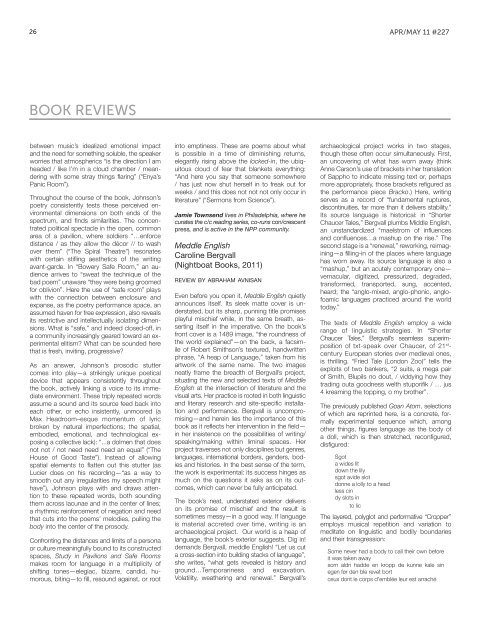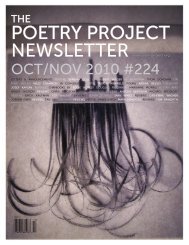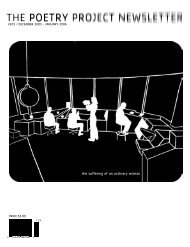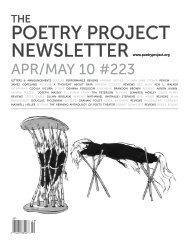26 APR/MAY 11 #227BOOK REVIEWSbetween music’s idealized emotional impactand the need for something soluble, the speakerworries that atmospherics “is the direction I amheaded / like I’m in a cloud chamber / meanderingwith some stray things flaring” (“Enya’sPanic Room”).Throughout the course of the book, Johnson’spoetry consistently tests these perceived environmentaldimensions on both ends of thespectrum, and finds similarities. <strong>The</strong> concentratedpolitical spectacle in the open, commonarea of a pavilion, where soldiers “…enforcedistance / as they allow the décor // to washover them” (“<strong>The</strong> Spiral <strong>The</strong>atre”) resonateswith certain stifling aesthetics of the writingavant-garde. In “Bowery Safe Room,” an audiencearrives to “sweat the technique of thebad poem” unaware “they were being groomedfor oblivion”. Here the use of “safe room” playswith the connection between enclosure andexpanse, as the poetry performance space, anassumed haven for free expression, also revealsits restrictive and intellectually isolating dimensions.What is “safe,” and indeed closed-off, ina community increasingly geared toward an experimentalelitism? What can be sounded herethat is fresh, inviting, progressive?As an answer, Johnson’s prosodic stuttercomes into play—a strikingly unique poeticaldevice that appears consistently throughoutthe book, actively linking a voice to its immediateenvironment. <strong>The</strong>se triply repeated wordsassume a sound and its source feed back intoeach other, or echo insistently, unmoored (aMax Headroom–esque momentum of lyricbroken by natural imperfections; the spatial,embodied, emotional, and technological exposinga collective lack): “...a dolmen that doesnot not / not need need need an equal” (“<strong>The</strong>House of Good Taste”). Instead of allowingspatial elements to flatten out this stutter (asLucier does on his recording—“as a way tosmooth out any irregularities my speech mighthave”), Johnson plays with and draws attentionto these repeated words, both soundingthem across lacunae and in the center of lines;a rhythmic reinforcement of negation and needthat cuts into the poems’ melodies, pulling thebody into the center of the prosody.Confronting the distances and limits of a personaor culture meaningfully bound to its constructedspaces, Study in Pavilions and Safe Roomsmakes room for language in a multiplicity ofshifting tones—elegiac, bizarre, candid, humorous,biting—to fill, resound against, or rootinto emptiness. <strong>The</strong>se are poems about whatis possible in a time of diminishing returns,elegantly rising above the locked-in, the ubiquitouscloud of fear that blankets everything:“And here you say that someone somewhere/ has just now shut herself in to freak out forweeks / and this does not not not only occur inliterature” (“Sermons from Science”).Jamie Townsend lives in Philadelphia, where hecurates the c/c reading series, co-runs con/crescentpress, and is active in the NPP community.Meddle EnglishCaroline Bergvall(Nightboat Books, 2011)review by abraham avnisanEven before you open it, Meddle English quietlyannounces itself. Its sleek matte cover is understated,but its sharp, punning title promisesplayful mischief while, in the same breath, assertingitself in the imperative. On the book’sfront cover is a 1489 image, “the roundness ofthe world explained”—on the back, a facsimileof Robert Smithson’s textured, handwrittenphrase, “A heap of Language,” taken from hisartwork of the same name. <strong>The</strong> two imagesneatly frame the breadth of Bergvall’s project,situating the new and selected texts of MeddleEnglish at the intersection of literature and thevisual arts. Her practice is rooted in both linguisticand literary research and site-specific installationand performance. Bergvall is uncompromising—andherein lies the importance of thisbook as it reflects her intervention in the field—in her insistence on the possibilities of writing/speaking/making within liminal spaces. Herproject traverses not only disciplines but genres,languages, international borders, genders, bodiesand histories. In the best sense of the term,the work is experimental: its success hinges asmuch on the questions it asks as on its outcomes,which can never be fully anticipated.<strong>The</strong> book’s neat, understated exterior deliverson its promise of mischief and the result issometimes messy—in a good way. If languageis material accreted over time, writing is anarchaeological project. Our world is a heap oflanguage, the book’s exterior suggests. Dig in!demands Bergvall, meddle English! “Let us cuta cross-section into building stacks of language”,she writes, “what gets revealed is history andground…Temporariness and excavation.Volatility, weathering and renewal.” Bergvall’sarchaeological project works in two stages,though these often occur simultaneously. First,an uncovering of what has worn away (thinkAnne Carson’s use of brackets in her translationof Sappho to indicate missing text or, perhapsmore appropriately, those brackets refigured asthe performance piece Bracko.) Here, writingserves as a record of “fundamental ruptures,discontinuities, far more than it delivers stability.”Its source language is historical: in “ShorterChaucer Tales,” Bergvall plumbs Middle English,an unstandardized “maelstrom of influencesand confluences…a mashup on the rise.” <strong>The</strong>second stage is a “renewal,” reworking, reimagining—afilling-in of the places where languagehas worn away. Its source language is also a“mashup,” but an acutely contemporary one—vernacular, digitized, pressurized, degraded,transformed, transported, sung, accented,heard; the “anglo-mixed, anglo-phonic, anglofoamiclanguages practiced around the worldtoday.”<strong>The</strong> texts of Meddle English employ a widerange of linguistic strategies. In “ShorterChaucer Tales,” Bergvall’s seamless superimpositionof txt-speak over Chaucer, of 21 st -century European stories over medieval ones,is thrilling. “Fried Tale (London Zoo)” tells theexploits of two bankers, “2 suits, a mega pairof Smith, Blupils no dout, / viddying how theytrading outa goodness welth stuporifik / … jus4 kreaming the topping, o my brother”.<strong>The</strong> previously published Goan Atom, selectionsof which are reprinted here, is a concrete, formallyexperimental sequence which, amongother things, figures language as the body ofa doll, which is then stretched, reconfigured,disfigured:Sgota wides litdown the lilysgot avide slotdonne a lolly to a headless cindy slots into lic<strong>The</strong> layered, polyglot and performative “Cropper”employs musical repetition and variation tomeditate on linguistic and bodily boundariesand their transgression:Some never had a body to call their own beforeit was taken awaysom aldri hadde en kropp de kunne kale sinegen før den ble revet bortceux dont le corps d’emblée leur est arraché
THE POETRY PROJECT NEWSLETTER27BOOK REVIEWSAnd a handful of lyric prose essays developingBergvall’s notions of language and writingprovides a counterpoint to “non-prose” textswhose insistence on the materiality of theirwords, letters and sounds can sometimes bechallenging or opaque.To the reader of formalist sensibilities, MeddleEnglish might feel too loosely crafted; to the rigorousconceptualist, the rules governing Bergvall’sdecisions on the micro-level of the line mightseem too difficult to track. But Bergvall is not a“poet’s poet,” and she isn’t trying to be: the textsof Meddle English weren’t written for the pagealone and the Modern formalist rubric mightnot really apply. Formally speaking, “ShorterChaucer Tales” is the most tightly wrought ofthe book’s non-prose texts, and the one that,along with Goan Atom, reads most comfortablyas text written for the page. But parts of the“Chaucer Tales” were included in Bergvall’s 2010exhibition/installation “Middling English” as bothaudio recordings and broadsides, a reminderof the fundamental importance of performanceand performativity to Bergvall’s work. Bergvall’spractice is opposed to the modernist notion ofa definitive, singular, “final” work, and to ask thisof Meddle English would be to do it a disservice.Especially since much of Bergvall’s workis freely available online to be heard, seen andinteracted with. Language isn’t only polyvocal,it’s multidimensional, and another imperative ofMeddle English, it seems to me, is to apprehendits texts in their multiplicity: to read themsimultaneously as poems, essays, scores forperformance, gallery wall texts, and exhibitioncatalog plates.Abraham Avnisan is a poet, visual artist, andwould-be psychoanalyst living and working inBrooklyn, NY.More Radiant SignalJuliana Leslie(Letter Machine Editions, 2011)review by nicole triggIn her first book, More Radiant Signal, JulianaLeslie shows real affection and energy for hermedium, loving (and demonstrating loving)what words do. <strong>The</strong> collection revels in definition,suggestion, substitution, multiplication,and affirmation, among other functions, and theoutcome is playful, abundant, and fast-paced.More Radiant Signal names the work perfectly,definitively, where Leslie celebrates the word asboth signification and radiance, asks for more ofwhat she desires and adores, then creates it.“Have you seen the green ray? / One possibilityis to apprehend the immediate and materialdarkness / Another is to walk a little further.” <strong>The</strong>lines that conclude the poem “From the Interiorof All Other Knowledge” read as an ars poeticapeculiar to the project. Leslie has seen and sees,and writes in pursuit of “the green ray” (otherwords for “radiant signal”), which is holographic,elusive, and infinite in one direction, says geometry.That direction is of course forward, whereLeslie goes unhesitatingly. Along the way shepauses here and there “to apprehend the immediate.”If the collection has any weakness, itis a reluctance to stay, to resist perpetual motionand linger in darkness. (Two poems that are notreluctant, and are immensely successful for it,are, “Several Always Before the One,” and “<strong>The</strong>Little Sound in the Middle of Simone.” <strong>The</strong>sepoems, in which Leslie sustains a kind of strainedembodiment in the one, and in the other, createsa sonic volume of s-sounds to house romanticfixation, make me wish for more like them. <strong>The</strong>nagain, their contrast to the pattern is part of theirsuccess.) Both options—to stay and to go—areof course necessary to perceive the green ray!Yet a preference is implied in the order of thelines: motion, over stasis, has the last word.<strong>The</strong> appetite for more, for extension and alsovariation or exchange, yields lines that bleedtogether over breaks while also operating discretely.Some poems call to mind rolling credits,or refreshing a web browser in repetition, wherelines read as equivalent or interchangeable,displacing each other. Leslie alludes directly tothis function in the second section of the poem,“Paul Klee”:Replace doubt with live color and the affirmationof color or substitute affirmation with actual texturesubstitute when a human body disappearswith wavelength or fold of blanketsubstitute and/or replace windwith beesAlternately, Leslie enacts substitution (versustelling it) in various poems, including “Articulation,”where anaphora underscores the effect:Someone is born in Bethlehem, PennsylvaniaSomeone is a marriage of cells to a houseI think this is what it means:To be speechless in front of a mirrorTo hire geraniumsTo be had as much as to haveA linguistic mode of substitution translates toimmateriality and lightness, which Leslie referenceswhen she writes, “Why don’t you carrya cardboard cutout / of what you believe”(“Beginner’s Mind”), and with the lines, “In thefuture time will be construction paper orange/ the heavens and all the spheres / will beconstruction paper orange” (“Illumination of theEarth for a Photo”). <strong>The</strong> flattening of spheres isa major concern, but not a threat—rather, it’san opportunity to make things, and thereforeliberating. Leslie works to exaggerate the linear;moreover, using crispy templates of math,theory, logic, etc., to frame parts of poems(contrasting with non-sequitur content), anddrawing attention to the literal lines that shapeletters (e.g., “L is for a lexicon of possible appearances.<strong>The</strong> visual form of how roads end,”from “<strong>The</strong> Importance of Rising Motion…”). Atthe same time, Leslie acknowledges the needfor dimensionality, which she achieves beautifullyin several places—here and there optingto “apprehend the immediate”—so anchoring aflammable, flappable (as in airborne) text.“<strong>The</strong> Painter of Modern Life” is an interestingcomposite of the two modes, motion and stasis.<strong>The</strong> poem begins in the former, multiple and hyperactive(“he tries to pile two lemons on topof one / he pulls paper over his mouth / playsa new game every hour”), then devolves intoexhaustion, imprecision, semi-blindness (“grappleswith water whistles / notes in many tones /focuses here and there / on sunspots”), to endin the latter mode (“forced to walk slowly / andrecollect your inner life”). As the poem downshifts,so does the speaker, seeming drunkenor dumbstruck, stating, “A ride on a train is veryexciting / My photo includes balloons”. <strong>The</strong> finallines of the poem, “become a cow a movingpendulum / the sun” enact gathering weightand roundness sonically (cow and pendulum)and hold us there in the unpunctuated, radiantlast sound, sun.<strong>The</strong> full title of the title poem has an importantextra word, which speaks to this issue ofsustained attention and embodiment: “softer”.“Softer More Radiant Signal” is an impressive,risky poem in which Leslie literally asks to gowhere she is uncomfortable, to stay in the darkbody. It begins, “Tell me more about…” andends as follows:More of that feelingthat accompanies an unsettledstate of beingMore of the condition of beingnaturally disposed to severaldifferent feelingstell me more about these wordsturbulent, euphoria, indiscrete
















